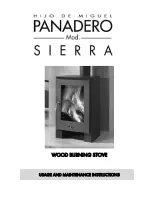
27
Cleaning of stainless and brushed surfaces
These surfaces do not normally require treating,
just avoid cleaning them with abrasive materials.
It is recommended to clean steel surfaces with a
paper tissue or a dry and clean cloth moistened
with a nonionic surfactant-based detergent ( <5%).
A spray detergent for glass and mirrors may be
suitable.
Avoid contact of the detergent with the
skin and eyes. Should that happen,
wash with plenty of water and seek
medical attention.
Heat stove maintenance and cleaning
Cleaning of painted parts
Avoid cleaning the painted parts when the
appliance is in operation or hot, to prevent
the thermal shock of the paint leading to its
detachment. Silicone paints have technical
features that allow them to withstand extremely
high temperatures. There is however a physical
limit (380°-400°) beyond which the pain loses its
features and starts “blanching”, or (over 450°)
“vitrifies” If these effects occur it means that the
temperatures that have been reached are well
above those at which the appliance should work
correctly.
Do not use abrasive or aggressive pro-
ducts or materials.
Clean with a moistened paper tissue
or cotton cloth.
Check every 7 days
Cleaning the lower ash pan
It is recommended to clean the ash pan from
residues dropped during operation. The ash pan
may be accessed by unscrewing the two wing nuts
holding the inspection drawer. Remove the pan,
empty it and only clean the walls and corners with
an ash vacuum cleaner or suitable tools. Then fit
the pan back on and screw the wing nuts back
on, paying attention to restore tightness, which is
essential during operation.
Check every 60-90 days
Cleaning internal turbulator compartment / flue
gas fan compartment
Inside the compartment where the the ash pan is
located, there is a second cover which accesses
the compartment located at the base of the flue
gas pass and flue gas suction fan.
Use an ash vacuum cleaner to accurately clean
this compartment.
Check integrity of the ceramic fibre gasket.










































